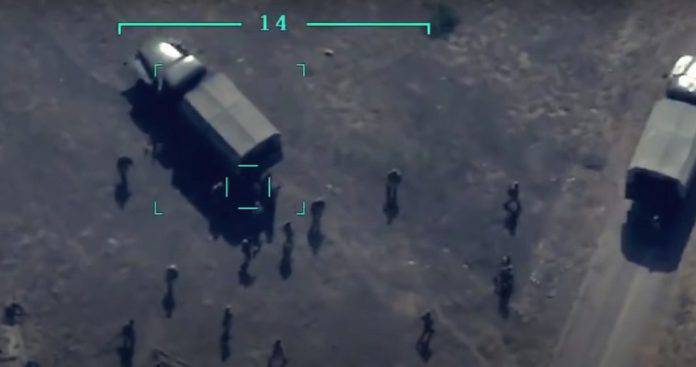Kostas Grivas: Military lessons for Greece from the defeat of the Armenians
12/11/2020
If the defeat of the Armenians is due to many factors, which should be considered at multiple levels, however, some initial (albeit precarious) conclusions can be drawn regarding developments in war methodologies and capable and inefficient weapons systems. The form of operations there, in fact, bears great resemblance to the battles against ISIS in Iraq and the war in eastern Ukraine a few years ago.
Although public attention has turned to unmanned aerial vehicles (UAVs), especially the Turkish Bayrarktar, it would be wrong to be trapped in a “fetishism” about the operational value of such aircraft. In and of itself it did not cause serious blows to the Armenian forces. Their value lay in the fact that they were integrated into systems of systems, forming strike – reconnaissance grids, with massive power projection capabilities, and at the same time with a high tolerance for losses. We also point out that the aircraft used are not very high technology.
In fact, the Nagorno-Karabakh conflict has been marked by the limited, almost non-existent role of high-tech, high-cost platforms such as modern fighter jets. This limited the role of air defense systems, such as the S-300, which are precisely aimed at dealing with fighters.
The Azeris did not rely on high-tech systems, but on their ability to inflict heavy losses on the opponent, combined with their ability to take heavy losses. They invested in low-tech means and in large numbers. One pillar of the Azeri power was strike – reconnaissance grids, the core of which were low-tech aircraft. They had them in large numbers, so they could suffer heavy losses. The second pillar was a large army on the ground, which consisted largely of mercenaries, who could also suffer heavy losses.
The aircraft were used both for strikes and mainly in intelligence gathering, surveillance and target acquisition (ISTAR) roles, directing artillery fire, and guiding infantry. An infantry with great tolerance for the losses caused to it by the ruthless, determined, and resourceful Armenians.
Dominance with commercial drones
The need for large numbers of expandable aircraft has become apparent in the West as well. As British Air Force chief Sir Stephen Hillier put it, during the conference on the future of air and space power, held in London (July 17, 2019), it is a crucial issue “to create more targets in the air”.
In particular, the RAF is concerned about the small number of fighter jets currently available and is therefore seeking, inter alia, to acquire unmanned fighters that will accompany the manned aircraft. These aircraft will have many roles, but the goal is to create larger fleets of expandable aircraft that will saturate the enemy air defenses. This is exactly what the Azeris did in Nagorno-Karabakh.
Similar is the approach of the US Air Force, which wants to frame its F-35 and F-15EX fighter jets with the unmanned XQ-58 Valkyrie made by Kratos Defense Security Solutions, or something similar. Valkyrie began to develop in July 2016, when the US Air Force awarded Kratos a contract under the Low Cost Attritable Aircraft program. The mass use of aircraft for reconnaissance or strikes is not a privilege of technologically advanced countries.
For example, during the SOFIC (Special Operations Forces Industry Conference) in Tampa, Florida (May 2017), General Tony Thomas, Commander of the US Armed Forces Interdepartmental Special Operations Command, stated that ISIS in Mosul had achieved “regular air supremacy” with the widespread use of modified commercial drones. They carried out reconnaissance and strike missions, carrying 40mm bomblets, or turning them into aerial improvised explosive devices.
The example of Eastern Ukraine
The value of the reconnaissance – strike grids was also evident from operations in eastern Ukraine in 2014-2015, where the Russians used artillery units flexibly. They were supplied with information from aircraft, special operations teams, and electronic warfare systems to quickly detect enemy forces and fire them in a rapidly changing battlefield.
For example, in July 2014, according to US intelligence sources, a single Russian artillery brigade destroyed two Ukrainian motorized battalions within minutes in the “Battle of Zelenopillya”. In particular, a force of the Ukrainian 79th Airmobile Brigade appeared at an advanced outpost and just 30 minutes later came under heavy fire from multiple BM-21 Grad rocket launchers, resulting in its destruction.
It is estimated that the Russians used special forces to locate the Ukrainians and passed the targeting data to the rocket launchers. The Russians also seem to have used electronic warfare systems, such as the PB-301B Borisoglebsk-2. This could interfere with or intercept radio signals and cell phone broadcasts, as the Ukrainians used cell phones at the beginning of the conflict to direct artillery fire, leading the Russians to intercept their signals.
Another system used by the Russians is the Leer-3, which is estimated to detect the coordinates of active cell phones from their GPS. In this way, it seems that the Russians targeted and destroyed several artillery units of the Ukrainian forces. To address the problem, the Ukrainians were equipped with Harris RF 7800V radios from the United States, which offer cryptographic communications.
According to Ukrainian Lieutenant General Andrii Koliennikov, Deputy Director of the Scientific Research Institute of the Military Equipment Directorate of Ukraine, 90% of Ukrainian casualties in this war came from artillery and mortar fire. Part of the Russians’ strategy was also to strike a crushing blow at the opponent’s command and control structure so that he could not respond to the Russian strikes. The doctrine of the use of Russian artillery seeks to minimize the time available to the enemy to return fire. It is noteworthy that the Russians used all the artillery systems at their disposal, old and new, even some that had been withdrawn.
The critical choice for the Greek Armed Forces
From the above it becomes clear that it is wrong, if not dangerous, to focus on increasingly few markets, for high-cost, high-tech battle platforms. These become unaffordable, precisely because of the high cost, the small numbers available, but also the long time required to replenish them in case of loss.
The situation becomes even more dysfunctional if combined with the inability to suffer great losses in human resources. And it becomes extremely dangerous when the opponent invests in multi-platform reconnaissance-strike grids that have high tolerances for losses, while his tolerances for human losses are also greater.
In addition, the debate over which frigate or fighter is better than the other is dangerously misleading. In the reality of war, what counts is the development of multi-system battle “entities”, which unite differently within an indivisible unit to inflict destructive blows on the opponent and with great tolerances to the blows received by him. That is why the expensive and incomplete battle platforms are not the appropriate means to strengthen Greek combat capabilities. Instead, they offer Achilles heel for an opponent!
Learning from the defeat of the Armenians
These conclusions are not necessarily negative for Greece. On the contrary, they offer huge opportunities if we want to invest in Greek ingenuity, in the rich scientific and technical potential , and if of course we utilize commercially available technologies. Today we are at the beginning of a series of great changes in the art, science, and technology of war, which are shaping a revolution in this field.
This is exactly the revolution examined by the signatory’s latest study “The New Military Revolution and the Greek Defense Strategy” (Livanis Publications). From this comes much of the information presented here. This revolution offers enormous opportunities for Greece, not only to strengthen the fighting capabilities of the army economically, but also to achieve a cooperative relationship of the national economy and defense, instead of being competitive as it is today.





